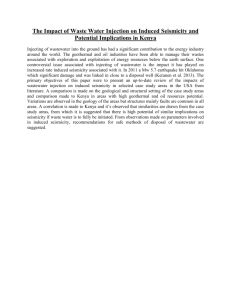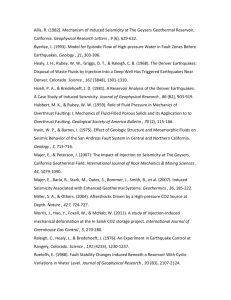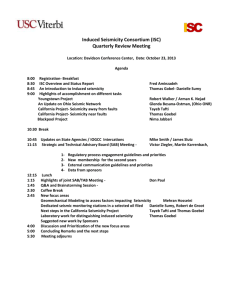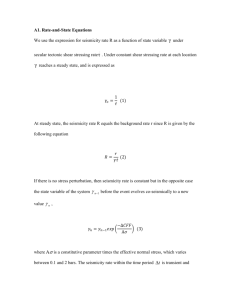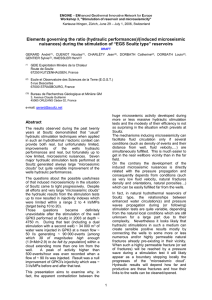THE SOULTZ EGS PROJECT AND ITS SOCIAL ENVIRONMENT: PUBLIC OPPOSITION
advertisement
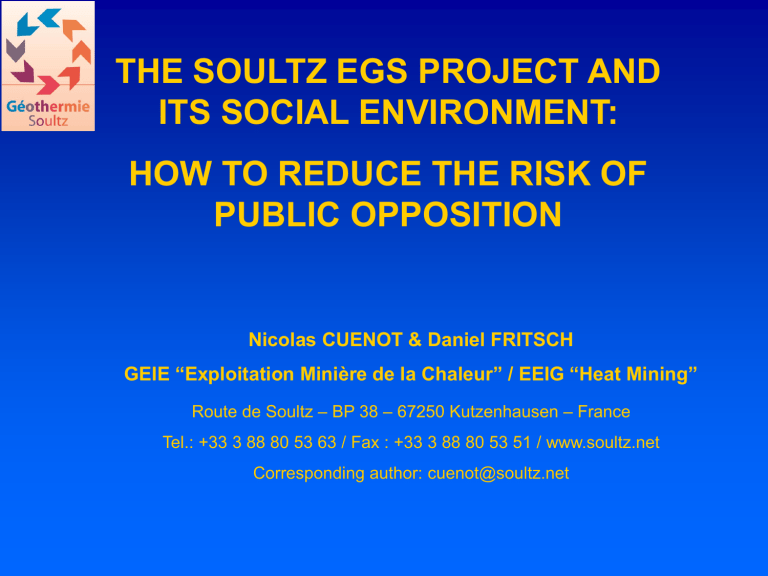
THE SOULTZ EGS PROJECT AND ITS SOCIAL ENVIRONMENT: HOW TO REDUCE THE RISK OF PUBLIC OPPOSITION Nicolas CUENOT & Daniel FRITSCH GEIE “Exploitation Minière de la Chaleur” / EEIG “Heat Mining” Route de Soultz – BP 38 – 67250 Kutzenhausen – France Tel.: +33 3 88 80 53 63 / Fax : +33 3 88 80 53 51 / www.soultz.net Corresponding author: cuenot@soultz.net OUTLINE: Hydraulic stimulations and induced seismicity Consequences for public acceptance Scientific research on larger magnitude events Scientific cooperation Use of other stimulation techniques Communication Hydraulic stimulation and induced seismicity 4 massive hydraulic stimulation experiments Injected volume Maximum flow rate Maximum overpressure Induced seismicity Larger magnitude events 13 MPa ~14000 (located) 75 (M≥1.8) 1 x 2.6 2 x 2.4 43 (M≥1.8) 1 x 2.9 2 x 2.7 GPK2 (2000) ~23400 m3 50 l/s GPK3 (2003) ~34000 m3 50 l/s; 60 & 90 l/s “Focused stimulation” 18 MPa ~22000 (located) GPK4 (2004) ~9300 m3 45 l/s 17 MPa ~5800 (located) 3 (M≥1.8) 1 x 2.0 19 MPa ~3000 (located) 17 (M≥1.8) 1 x 2.6 1 x 2.3 GPK4 (2005) ~12300 m3 45 l/s Hydraulic stimulation and induced seismicity Consequences for public acceptance growing fear due to: • the largest earthquakes (vibration, sound, moving objects) • repetition of felt earthquakes (within a short period and from one stimulation test to another) lots of phone calls (complain or ask for information) complaints to local authorities from individuals or associations articles in local newspapers around 30 complaints for presumed damages, which were evaluated by experts from insurance companies long-term risk of strong opposition to the project Scientific research First action → scientific research to understand the occurrence of the stronger earthquakes: presence of large faults, able to produce seismic events of such magnitudes high stress drop: strong energy release on small fractures From Dorbath et al., 2007 Scientific research Other actions: Installation by EOST of a permanent surface seismological network before the stimulation of GPK3 Installation of surface accelerometers at different places in Soultz to monitor the effective ground acceleration From Dorbath et al., 2007 Scientific research International cooperation creation of an independent experts group, which is in charge to evaluate the stimulations programs in terms of seismic risk participation to different workshops on induced seismicity creation of an EHDRA workgroup “Seismohydraulics”: 4 meetings were organized to discuss issues related to stimulation processes Organization of a yearly EHDRA Scientific Meeting, with at least one session dedicated to microseismicity Technical measures In order to limit the induced earthquakes in terms of number and magnitude, we try to act on the medium by performing chemical stimulations instead of pure hydraulic stimulations, as we know that the fractures are sealed by hydrothermal deposits (calcite, silica and clays) a one-year program was built with the help of geochemists and companies, which have experience in chemical stimulation GPK4 was the target, as this well exhibited a low productivity index after the 6-months circulation test RMA (Regular Mud Acid) in May 2006; max flow rate: 28 l/s, aiming at dissolving minerals like clay, feldspars and mica. Chelatants (NTA) in October 2006; max flow rate: 40 l/s, aiming at acting on calcite OCA (Organic Clay Acid) in February 2007; max flow rate: 55 l/s, used in high temperature medium with high clay content. Technical measures Results of the chemical stimulation program: Improvement of the productivity of the well lower volume of injected fluids; Lower flow rates, except for short periods (“flush”) → lower overpressures RMA: ~20 seismic events, highest magnitude: 1.9, but the earthquake was not felt. NTA: no seismicity OCA: ~80 seismic events, highest magnitude: 1.5 direct consequence: NO complaint from the population and a more peaceful environment around the project Upper figure: seismicity during the RMA test Lower figure: seismicity during the OCA test both from EOST (J. Charléty & L. Dorbath) Communication Before any stimulation test, a information letter is sent to the population to present the stimulation program and the possibility of induced seismicity Following the strongest event, public information meetings were organized by the EEIG with the participation of seismologists to explain the stimulation tests and to give more precise information about induced seismicity and, to a larger extent, seismology A small macroseismic investigation was achieved after the M=2.9 earthquake to get information about how people felt the vibrations Accelerometers were installed in the Police buildings and in the cellar of one inhabitant’s house to record the effective ground acceleration (presumed site effect) Communication Organization of a public information meeting every 2 months to present the project • 40 to 50 people at each meeting, mainly students and local population • numerous questions about the project, and mainly about earthquakes • people looks very interested and satisfied after the meetings Organization of special information meetings for associations, groups of students, companies… Publication of a regular 2-folds newspaper, which is written in 3 languages and distributed to a large audience to present the development of the project and the main events. The Web site is regularly updated. Conclusions Working on three different ways contributed to significantly increase the social acceptability by producing a more quiet environment around the project for 2 years now: • Scientific → better understanding of induced seismicity • Technical → use of low seismicity-inducing stimulation techniques • Communication → better information to a motivated population The population and local authorities now fully supports the project, since they noticed that we are doing our best to avoid the possible nuisances, or at least, to inform them honestly about them For the future, once people will see the concrete achievement of our project (and others), they will be able to make a better balance between the benefits given by geothermal projects and the possible disturbances related to their development.
